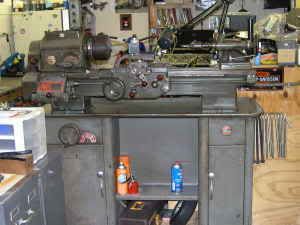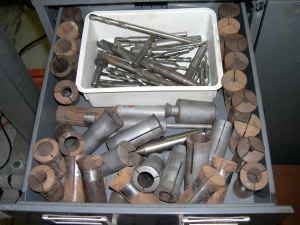"Direct" is with the motor pulley driving the spindle in 1:1 (not counting potential initial differential from the Reeve's Drive controlled by the lever or wheel speed control). "Back Gear" is an additional gear reduction (usually, which is the case in the Rockwell) inside the headstock. In this case, when you pull the top plate off, you'll see the belt driven spindle on top. There is another shaft directly below it, and that is the back gear shaft. Look at the teeth on all 4 gears, but usually if it's shed teeth, it will be on the front big gear, sometimes with additional damage on the smaller mating gear. If this is bad, you probably want to walk away unless it is exceptionally well tooled or VERY cheap. In fact, if it's cheap, AND the back gear is bad, the best thing to do is part it out. If this turns out to be the case, and it has a steady or follow rest, or taper attachment, I would appreciate an email or PM.

I could also use a second tailstock.

I parted out a Rockwell 11" "Turret Lathe" (no threading or normal apron) a while back. I could have made a few bucks on it, but all I wanted was the quick acting cross slide. But the point is that there are enough people out there trying to maintain or rebuild these that parting out is a viable option.
Lever TS (tail stock) feed is simply replacing the tailstock quill (the round part that moves and holds tooling) with a long version that is actuated by a lever rather than a hand wheel and screw. Much faster and easier for drilling deep holes due to the faster and much longer travel, but doesn't work so well with other tooling like centers and such. Making a second lever feed tailstock is why I want another tailstock casting.
The spindle bore is roughly 1.380 with either an MT4.5 or MT5 "stub" taper in the front. Which taper is a matter of some contention as Rockwell did not document it in any currently known documents, and the two are VERY close to identical. In any case, there should be 2 bushings to fit in the nose. One adapts to MT2 (that's what Rockwell shipped) and the other adapts to 5C. If you don't know, MT is for Morse Taper, which is the commonly used taper family for taper shank drills, drill chuck arbors, centers, and all manner of tooling.
And yes, 5C is the primary/standard collet for lathes, though there are MANY others out there. R8 is unsuitable as it is too small to start with, and it uses a draw bar threaded into the collet for closing. R8 is considered a tool holding collet, where 5C is a work holding collet. 5C is physically larger, (typically) requiring a 1.375" or larger bore, and holding up to 1" stock that is allowed to pass through the collet all the way out the back of the spindle (this is why the closer is a tube) for "bar feeding' or otherwise working with long stock. You can even get collets over 1", up to 1.250 (I think?), but that is pushing the limits and generally won't pass the stock through due to ID neck down to fit the closer threads. Many 5C also have internal threads for fitting a depth stop, but many do not. They typically do not come cheap for good names like Hardinge or Royal, so hopefully it will come with a set. If not, you might pressure into including.
Another nice thing about 5C is that most fixturing tooling uses it. So there are "indexers" and "collet blocks" as well as "collet chucks" and other stuff. For this reason, 5C is probably one of the most versitile collets out there. However, it has a VERY narrow clamping range, and if you exceed it, you can damage or even ruin the collet. More modern designs like the ER or TG style collets have much wider ranges and actually hold better too, but they lack the wide range of supporting tooling. Starting to get the idea that this topic is pretty broad? Just wait, we haven't even got started good yet...

If it's a good one, in good condition, and well tooled, for a good price, and and the size fits your expected needs, then you would be hard pressed to do any better in my opinion. As I said, the only reason I'm considering a Mori (or the like) is I want the larger spindle bore (over 2") along with more power and a higher top speed. But that's just a pipe dream at this point and I really can't justify anything more than my Rockwell 11x37.
And I know about space issues. I have all my stuff in a 1 car detached garage. There is no more than a single wide (one person) walk path that goes in the big door on the narrow end, about 1/3 of the way across, down about 3/4 of the way to the back, across, and back to come out about 1/3 of the way across the door opening from the other side. Just a "U" shaped path.

If you get this, let me know and I'll set you up with all the electronic resources I've managed to find.


 I have a few more questions, though. I've learned a lot but there is much MUCH more!
I have a few more questions, though. I've learned a lot but there is much MUCH more! I could also use a second tailstock.
I could also use a second tailstock.  I parted out a Rockwell 11" "Turret Lathe" (no threading or normal apron) a while back. I could have made a few bucks on it, but all I wanted was the quick acting cross slide. But the point is that there are enough people out there trying to maintain or rebuild these that parting out is a viable option.
I parted out a Rockwell 11" "Turret Lathe" (no threading or normal apron) a while back. I could have made a few bucks on it, but all I wanted was the quick acting cross slide. But the point is that there are enough people out there trying to maintain or rebuild these that parting out is a viable option.
